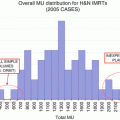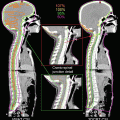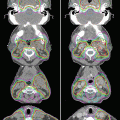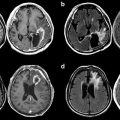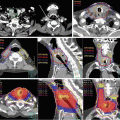Study [Reference]
Patient number
Stage of cancer
Rate of T3-T4 disease
Dose (Gy)
Hormonal therapy
Median f/u (year)
bNED
DSS
OS
Late GI toxicity
Late GU toxicity
Shipley [16]
202
T3-4N0M0
100 %
75.6
No
5.1
N.S. (LC improved)
N.S.
N.S.
Increased
Increased (stricture)
67.2
Sathya [17]
138
T2-3N0M0
39–40 %
40 + implant 66
No
8.2
Improved (p = 0.024)
–
N.S.
Slightly increased (p = 0.09)
N.S.
Zietman [18]
393
T1b-T2bN0M0
0 %
79.2
No
5.5
Improved (p < 0.01)
–
N.S.
Increased (p = 0.05)
N.S.
PSA < 15
70.2
MRC RT01 [19]
843
T1b-T3aN0M0
43–45 %
74
3–6 M
5.3
Improved (p = 0.007)
–
N.S.
Increased (p < 0.05)
N.S.
PSA ≤ 50
64
NA-HT
Dutch [20]
669
T1a-4N0M0
37 %
78
NA-/A-HT (n = 143)
9.2
Improved (p < 0.05)
N.S. (Improved in PSA = 8–18
N.S.
Increased (p = 0.04)
N.S.
PSA < 60
68
MDACC [21]
301
T1b-3N0M0
17 %
78
No
10
Improved in PSA > 10 (p = 0.013)
Improved in PSA > 10 (p = 0.05)
N.S.
Increased (p = 0.013)
N.S.
70
GETUG 06 [22]
306
T1b-T3aN0M0 PSA < 60
12–13 %
80
No
5.1
Improved (p = 0.036)
–
–
N.S. (p = 0.22)
Increased (p = 0.05)
70
Studies assessing dose escalation using IMRT in patients with locally advanced prostate cancer are even rarer. Most dose escalation studies treating prostate cancer with IMRT [23–28] are summarized in Table 20.2. The incidence of T3-4N0M0 disease was very low (3.6–12 %), except for two reports with rates of 35 and 48 %. Although a study by Takeda et al. included 48 % of patients with T3N0M0 disease, 45 of these 141 patients (36 %) received pelvic lymph node dissection to confirm metastatic disease [28]. Therefore, there is likely to be a strong selection bias in this patient cohort. In addition, they did not report the number of patients who were diagnosed with T3N0M0 disease, but then excluded from the study after re-diagnosis with N1 disease following pelvic lymph node dissection.
Table 20.2
Summary of dose escalation studies by IMRT in nonmetastatic prostate cancer with the median follow-up period of > 4.5 years
Study [Reference] | Patient number | Stage of cancer | Rate of high-risk disease | Rate of T3-T4 disease | Dose (Gy) | Hormonal therapy | Median f/u (year) | bNED survival rate of high risk | OS | Late GI toxicity rate (≥grade 2) | Late GU toxicity rate (≥grade 2) |
|---|---|---|---|---|---|---|---|---|---|---|---|
Alicikus [23] | 170 | T1c-4N0M0 | 19 % | 5 % | 81 | No A-HT | 8.3 | 62 % at 10Y | – | 3 % at 10Y | 16 % at 10Y |
Spratt [24] | 1002 | T1c-T4N0M0 | 34 % | 12 % | 86.4 | Yes (59 %) | 5.5 | 68 % at 7Y | 4 % at 7Y | 21 % at 7Y | |
Vora [25] | 303 | T1a-3bN0M0 | 23 % | 4.6 % | 75.6 (70.2–77.4) | Yes (35 %) | 7.6 | 53 % at 9Y (bNED rate) | 12 % | 24 % | |
Gadia [26] | 140 | T1a-3bN0M0 | 29 % | 3.6 % | 74–80 | – | 4.8 | 75 % at 5Y | 15.7 % | 20.2 % | |
Sia [27] | 125 | T1-4N0M0 | 65 % | 35 % | 74 | Yes (variated) | 5.5 | 76 % at 5Y | 1.4 % at 5Y | 2.2 % at 5Y | |
Takeda [28] | 141 | T1-3N0M0a | 74 % | 48 % | 76 or 80 Gy | Yes (88 %) | 5 | 82 % at 5Y (bNED rate) | 6 % | 6.3 % |
Zelefsky et al. reported the long-term outcome of 296 patients with T3 N0M0 prostate cancer treated with 3D-CRT or IMRT using delivered doses ranging from 66 to 86.4 Gy [29]. They reported comparable tumor control and survival outcomes with the surgical series and concluded that the potential of conformal radiotherapy as a standard management option for locally advanced prostate cancer had been confirmed. However, this study included patients treated with suboptimal doses (<70 Gy), and the number of patients treated using IMRT among the 296 cases was not reported. In addition, 36 % of patients were treated with EBRT alone, which is not consistent with the current standard approach of EBRT combined with HT for patients with locally advanced prostate cancer [30]. There are also currently no reports describing the long-term clinical outcomes of patients with locally advanced prostate cancer treated using high-dose IMRT combined with HT.
20.2.2 Prophylactic Pelvic Lymph Node Irradiation
A recent study performed extended pelvic lymph node dissection and reported that >10 % of patients with clinically localized prostate cancer harbor pelvic lymph node metastases [31]. Furthermore, pelvic lymph node metastases were found in 30–40 % of high-risk patients who received extended pelvic lymph node dissection [32]. Therefore, an increased incidence of occult pelvic lymph node metastases is expected in patients with locally advanced prostate cancer, and it is reasonable to expect an improved outcome in patients at high risk of pelvic lymph node metastases by applying prophylactic radiation therapy to the pelvic lymph nodes.
However, the three prospective randomized trials performed to date have failed to demonstrate progression-free and survival benefits of prophylactic irradiation to the pelvic lymph nodes [33–35]. In those studies, the total dose delivered to the prostate was suboptimal (65–70 Gy) in relation to the current standard of care. This is because if 45–50 Gy had already been delivered to the pelvic lymph node regions using conventional techniques, including 3D-CRT, the prostate dose has to be limited to 70 Gy to avoid a higher risk of late radiation injury to the rectum. Only a subset analysis in the RTOG 94–13 trial, which compared both prostate-only radiation (PORT) with whole pelvic radiation (WPRT) and short-term neoadjuvant hormonal therapy (NA-HT) with adjuvant hormonal therapy (A-HT), suggested a slight progression-free benefit in patients treated with WPRT combined with NAHT compared with the other three arms [33]. In contrast, the beneficial effects of dose escalation to the prostate on biochemical recurrence-free outcomes are more consistent and clear, as described in Sect. 20.2.1 [15, 14]. Therefore, based on the available data, it would be reasonable to recommend selecting local dose escalation over prophylactic pelvic node irradiation using 3D-CRT.
On the other hand, IMRT can realize local dose escalation to both the prostate and pelvic lymph node areas concurrently using the simultaneous integrated boost (SIB) IMRT technique [36]. In this approach, the effect of pelvic irradiation can be superimposed on improved local control using high-dose local irradiation; therefore, the effect of pelvic irradiation might be significant. To date, SIB-IMRT has been applied mainly to high-risk patients and appears to be acceptable and promising in terms of both short- to intermediate-term clinical outcomes and toxicity [37–39]. However, its true clinical benefits need be validated in future prospective randomized trials.
20.2.3 Combined Hormonal Therapy
A meta-analysis of randomized controlled trials demonstrated that combined HT with EBRT improves survival outcomes significantly compared with EBRT alone in patients with intermediate- and high-risk diseases [30]. However, there are several limitations to the studies included in this meta-analysis. First, for the most part, conventional radiation techniques were used. In addition, the total dose delivered to the prostate ranged from 65 to 70 Gy, which is considerably lower than the modern standard of care using more sophisticated radiation techniques such as 3D-CRT and IMRT. In addition, the optimal duration and timing of HT remain controversial. The clear survival advantages reported in a study comparing EBRT followed by long-term HT with EBRT alone [40] were small or insignificant when compared with short-term HT plus EBRT [41, 42].
Another important unsolved issue regarding HT is the optimal timing for initiating salvage hormonal therapy (S-HT) in patients who develop recurrence after EBRT. It would be expected that if the initiation of S-HT is delayed, a poor prognosis is likely compared with patients who are treated at an earlier date. Consistent with this, it was reported that the early initiation of S-HT improved the prognoses of patients with recurrent disease after definitive EBRT for prostate cancer [43, 44]. However, the timing of the initiation of S-HT has not been defined in any previous studies assessing the impact of HT on EBRT. In addition, in the RTOG 86–10 trial, which explored the effect of short-term NA-HT in patients with bulky localized tumors, S-HT was not initiated in ~30 % of recurrent cases until distant metastases had become obvious, and S-HT was not started in >70 % of patients until their PSA values exceeded 20 ng/ml [44]. This suggests that S-HT was delayed in the radiotherapy alone or short-term HT arms in previous randomized trials, although the exact data were not reported.
Intermittent hormonal therapy (I-HT) has become a popular treatment modality to delay the development of castration resistance and reduce the side effects and cost of HT by replacing continuous HT (C-HT). Recently published meta-analyses and systematic reviews have reported that I-HT is comparable with C-HT in terms of overall survival in patients with recurrent, locally advanced, or metastatic prostate cancer [45–47]. This suggests that treating locally advanced prostate cancer with EBRT plus short-term HT, with an early salvage policy, which is similar to performing I-HT after completing short-term NA-HT plus EBRT, could achieve comparable survival outcomes to those patients who had received long-term A-HT after EBRT. This is consistent with data reported from Kyoto University using IMRT combined with short-term NA-HT under an early salvage policy that we describe below.
Therefore, the optimal duration of HT in combination with high-dose EBRT using modern radiation techniques should be confirmed in a prospective study in which S-HT is initiated during the early phase of recurrence.
20.2.4 Hypofractional Approaches
Because the α/β value of prostate cancer has been reported to be lower than those of normal structures adjacent to the prostate, the fractionation sensitivity differential (tumor/normal tissue) theoretically favors the use of hypofractionated radiotherapy schedules. However, α/β and the application of a hypofractioned radiation regimen to prostate cancer remain controversial [48]. Recently, two studies based on large-scale data confirmed that the α/β for prostate cancer is low [49, 50]. An assembled study assessing seven datasets including ~6,000 cases confirmed that the value of α/β for the pooled data was 1.4 (95 % confidence interval [CI] = 0.9–2.2) Gy [49]. There was no significant difference between the α/β value for the three risk groups (low, intermediate, and high risk), and androgen deprivation did not affect the value of α/β. Another study analyzed the PSA data of 5,093 patients from six institutions treated for localized prostate cancer using EBRT without planned androgen deprivation and estimated that the α/β ratio was 1.55 Gy (95 % confidence band, 0.46–4.52 Gy) [50].
Therefore, a hypofractional approach is theoretically more favorable for both biochemical control and late toxicity. This approach is also favorable in terms of patient convenience and cost-effectiveness. However, recent randomized studies with relatively long-term follow-up periods, in which high-dose deliveries in conventional fraction sizes (76/80 Gy at 2 Gy per fraction) were compared with a hypofractional approach (70.2 Gy at 2.7-/63 Gy at 3.1 per fraction), failed to show improved biochemical control using hypofractional regimens [51, 52]. In both studies, the biochemical outcomes and late radiation toxicities were comparable between fractionation schedules. Although more data and longer follow-up periods are necessary to draw a definitive conclusion, a hypofractional approach might be beneficial to patients in terms of a shorter treatment time and lower cost if the outcomes were at least comparable with conventional fractionations.
20.2.5 High-Dose IMRT for Locally Advanced Cases at Kyoto University
At Kyoto University, we currently perform image-guided (IG) IMRT with prostate-based positional correction based on cone-beam CT using Vero4DRT (MHI-TM2000) (Mitsubishi Heavy Industries, Ltd., Tokyo, Japan, and BrainLAB, Feldkirchen, Germany) [53, 54] for localized (T1-T2N0M0) prostate cancer. However, we have used bony structure-based IG-IMRT using Novalis (BrainLAB, Feldkirchen, Germany) for locally advanced cases. This is because the theoretically reasonable margin reduction associated with switching from bony structure-based IGRT to prostate position-based IGRT (5 mm reduction in the anterior-posterior and cranial-caudal directions, 3 mm in the left-right directions) [55] resulted in a significant degradation in the biochemical control rate [56]. We are particularly concerned with the possible higher risk of margin reduction in locally advanced (T3-T4N0M0) cases.
We reported the IMRT outcomes of T3-4N0M0 prostate cancer combined with NA-HT previously [57]. Between January 2003 and May 2006, 103 Japanese patients with T3-4N0M0 adenocarcinoma of the prostate were definitively treated with IMRT. The median age of the patients was 71 years (range 51–80). Initial PSA (iPSA) values were 5–179 ng/ml (mean, 37; median, 26 ng/ml). Gleason score (GS) was distributed as follows: 6 in eight patients, 7 in 49, and ≥8 in 46. NA-HT (range, 4–15 months; median, 6) was performed in all cases. Seventy-eight Gy in 39 fractions was administered to the prostate and seminal vesicles in 94 patients, whereas the doses were reduced to 70 or 74 Gy in nine patients due to factors such as anticoagulant therapy. A detailed description of the IMRT treatment planning was reported previously [58, 59]. No patients received A-HT, and a uniform S-HT policy was generally applied. S-HT was initiated once the PSA value exceeded 4 ng/ml in a monotone increasing manner or when any clinical failure was detected.
The median follow-up period was 68 months (range 21–89). The estimated biochemical relapse-free survival (bRFS) rate based on the Phoenix definition using the Kaplan-Meyer method was 69 % (95 %CI = 59–78) at 5 years (Fig. 20.1). Among age, NA-HT duration, GS, iPSA, and T-factor, only iPSA and T-factor were significant independent factors for predicting bRFS outcome in both univariate and multivariate analyses. The 5-year bRFS rates for T3a and T3b-T4 cases were 78 (95 %CI = 68–88) and 50 % (95 %CI = 32–68), respectively (p = 0.0089; Fig. 20.2). The 5-year salvage HT-free rate was 75 % (95 %CI = 68–83; Fig. 20.3), and the prostate cancer-specific and overall survival rates were 98 (95 %CI = 95–100) and 95 % (95 %CI = 91–99), respectively (Figs. 20.4 and 20.5).
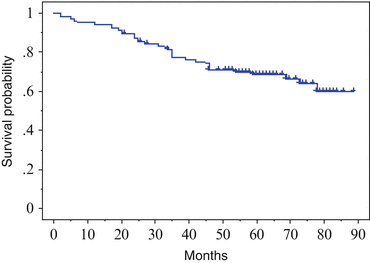
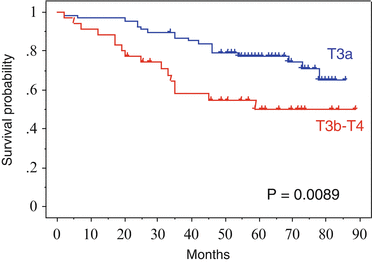
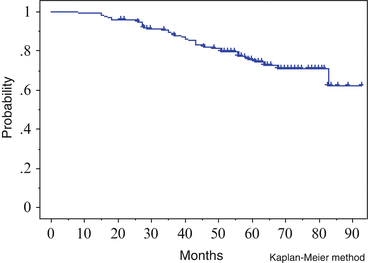

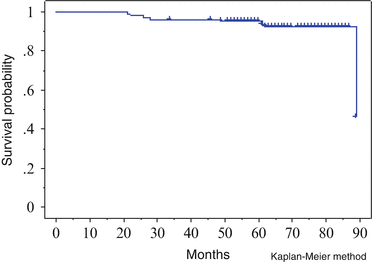

Fig. 20.1
Kaplan-Meier curve estimating PSA failure-free survival rate based on the Phoenix definition. The 5-year survival rate was 69 % (95 %CI = 59–78)

Fig. 20.2
Kaplan-Meier curve estimating PSA failure-free survival rate by T-stage based on the Phoenix definition. The 5-year survival rate was significantly better in T3a cases (78 %, 95 %CI = 68–88) compared with T3b–T4 (50 %, 95 %CI = 32–68; p = 0.0089)

Fig. 20.3
Kaplan-Meier curve estimating the salvage hormonal therapy-free (S-HT-free) rate. The 5-year S-HT-free rate was 75 % (95 %CI, 68–83)

Fig. 20.4
Kaplan-Meier curve estimating the disease-specific survival (DSS) rate. The 5-year DSS rate was 98 % (95 %CI, 95–100 %)

Fig. 20.5
Kaplan-Meier curve estimating the overall survival (OAS) rate. The 5-year OAS rate was 95 % (95 %CI, 91–99 %)
Therefore, high-dose localized IMRT in patients with locally advanced prostate cancer combined with NA-HT using an early salvage policy (PSA >4 ng/ml) resulted in both a high salvage-free rate (75 % at 5 years) and excellent survival outcomes in an intermediate follow-up period. This approach might be an alternative to uniformly administering long-term A-HT, although longer follow-up and prospective studies are needed to confirm this hypothesis. Typical PSA transitions in patients who maintained a long-term HT-free status are presented below in Sects. 20.4.1 and 20.4.2.
We also applied whole pelvic (WP) SIB-IMRT to locally advanced tumors with very high-risk features such as PSA >30 ng/ml or T3b [60]. We maintained the same total dose and fraction size as to the prostate (78 Gy in 2 Gy per fraction) so that the impact of adding WP irradiation could be assessed by comparing the data with historical controls who received the same dose of localized irradiation alone. Therefore, the pelvic lymph node area was simultaneously irradiated using the SIB technique at 1.5 Gy per fraction up to 58.5 Gy. The interim outcomes of this approach are reported below. The policies for combined NA-HT and S-HT were the same as for localized IMRT. Therefore, A-HT was not administered to this cohort of 46 patients with T3-T4N0M0 disease. With a median follow-up period of 44 months (range, 18–72), the bRFS rate according to the Phoenix definition and salvage-free rates at 42 months were 78 (95 %CI = 65–91 %) and 80 % (95 %CI = 68–93 %), respectively. Despite the very high-risk nature of these tumors (median iPSA, 59.4 ng/ml), these interim outcomes are encouraging. A typical case is presented below in Section 21.4.3.
20.3 Node-Positive (N1) Prostate Cancer
20.3.1 EBRT for Node-Positive (N1) Prostate Cancer
Node-positive, but distant metastasis-negative (TanyN1M0), prostate cancer is relatively rare in patients diagnosed with prostate cancer at their first visit [5, 61]. The prognosis of patients with TanyN1M0 disease is generally poor [62]. Because TanyN1M0 is relatively rare, there are few prospective studies available. In addition, the number of cases included in retrospective studies was not always sufficient to draw definitive conclusions. Nevertheless, it is known that EBRT plus long-term hormonal therapy resulted in better survival outcomes compared with EBRT alone, radical prostatectomy alone, or immediate HT alone [62]. Pollack et al. reported that the disease-free and overall survival rates at 5–10 years were ~20 and 50 %, respectively, in patients treated with EBRT, radical prostatectomy, or hormone therapy alone [62]. In contrast, the respective survival rates in patients treated with combined hormonal therapy plus EBRT were ~50 and 70 %.
Stay updated, free articles. Join our Telegram channel

Full access? Get Clinical Tree


